 | |||
| You Are Here. | |||
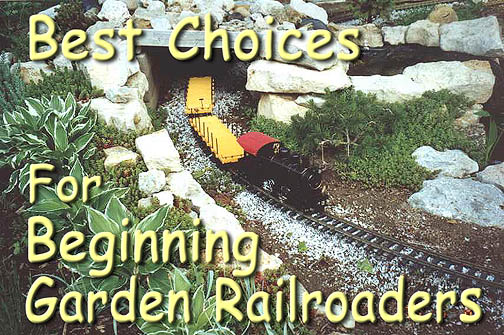 |  |
 | |
 |
 | ||
 |
 | ||
 |  | ||
 |  | ||
 | |||
| You Are Here. | |||
 |  |
 | |
 |
 | ||
 |
 | ||
 |  | ||
 |  | ||
Written by Paul D. Race for Family Garden Trains(tm)
 and
Garden Train Store(tm) and
Garden Train Store(tm) |
|
Another helpful Primer article is "Building a Garden Railroad on a Budget." That article gives you some idea of the sort of expenses you may incur as you begin to move your trains outside. That article argues in favor of taking "baby steps" when you're starting out. But if you work your way through the sample budget sheets in that article, you'll soon realize that:
I can't help you order bolders and mulch online, or even with Dwarf Alberta Spruces, but I can help you make the most useful initial investments in track, trains, and structures. The goal of this page is to save you time and money by helping you locate the most useful (and generally the most affordable) products for when you're first starting out. Update for 2015 - Every year we rework our "short list" of products folks should consider starting out with. Some years the list gets shorter; some it gets longer, depending on the state of the economy three years ago - yes, it takes 18-36 months for global economic changes to affect our market. Thank goodness, we've had a few good years in a row, so stuff that was hard to find in 2010-2013 is starting to reappear again. The other thing that has happened is that several vendors who used to do their online business through sites we could link to directly are now doing most of that business through Amazon. So most of our train links just go there these days. Once you get to an Amazon page, though, you can often find multiple vendors selling the same thing. So you can do "competitive shopping" (more-or-less) directly from the Amazon page. Also, certain train products tend to come online late in the season. So once you get to a product's Amazon page, look at the "other people have bought" and "other people have looked at" lists to see if something's come online since I most recently updated this page. For information about why model trains and related products seem to "come and go" even in good years, please see our article "About Pricing and Availability." Please contact us if you have questions about availability, quality, or, suitability of any product listed on this page. A Note about "Buyer's Guides" We post these descriptions to help you make informed decisions and to learn what is available, even if the suppliers we usually recommend have a short supply. In some cases, we will allow a description to remain online, even without a supplier link, if we have reason to believe that the product will become available again later. If you want a particular product, but we have no supplier button or the supplier's page says they are sold out, let us know, and we'll try to help you find one elsewhere. We apologize if this causes you any inconvenience or confusion. Note about Suppliers: While we try to help you get the products you want by recommending suppliers with a good record of customer service, all transactions between you and the supplier you chose to provide your trains or other purchases are governed by the published policies on the supplier's web site. So please print off any order confirmation screens and save copies of invoices, etc., so you can contact the appropriate supplier should any problems occur. (They almost never do, but you want to be on the safe side.)
Stuff You'll Need at FirstChances are your initial purchases will be along the following lines:
Starter SetsIf you haven't already picked up a Large Scale starter set, you're in for a treat. Large Scale manufacturers such as those represented on this page have been making detailed, reliable trains for decades, and each year the products get better. A few samples that have a reputation for quality and which should be widely available are shown on this page. These sets come with track that is most suitable for indoor use in tight quarters, say around a Christmas tree or on a test track, but you'll want to use wider curves outside. The AristoCraft set also comes with a very handy remote control that you can use outside if your railroad doesn't get too big. Note: For more sets and for more details on the sets listed here, please check out the Garden Train Starter Set page.
|
Track for OutsideWhen you move your trains outdoors, you'll want to give them room to run. Trains look better and run better on wider curves. You will never regret choosing good track at the outset and installing it properly.LGB invented the track that most garden trains run on. Track from AristoCraft/GeneratioNext and USA Trains is totally compatible with LGB, but it has better connectors. Bachmann's brass track (not the stuff that comes with their trains) is also compatible with the other brands shown here. Note: Piko's larger curves aren't always exactly the same as the other brands, so if you have to mix and match curves, consider sticking with the other three brands on this page. Otherwise read the product discriptions carefully. Because of the uneven availability of track in 2014, you might wind up using track from more than one manufacturer. That's why we have a cross-reference list of the most popular pieces. The pieces that I've found most useful are shown in bold. For more details on the track options listed here, as well as many other choices, please check out the Garden Railroad Track Options page.
|
BuildingsWhen I first put this page online, several nice pre-built buildings were available. But most of the buildings available today are kits. That's okay; I always recommend painting buildings before you put them out, and it's a lot easier to paint a kit than a finished structure.About "Beginning" Piko Structures The first several Piko structures listed below use essentially the same basic components and construction, so if you start, say with the smallest "Gingerbread" house, then move on to the schoolhouse or stores, you'll be able to apply any "lessons learned" as you progress. For maximum results, follow our detailed instructions on painting and assembling these. | |||||
Piko Gingerbread Houses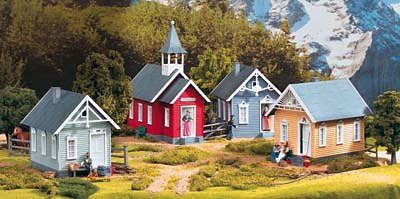 | ||||
Piko Gingerbread Houses - These little houses are great for setting up a small town without a lot of space. They look tiny in the photo (taken from the package's cover art), but they're large enough to look fine with any garden train. In addition, I have a whole 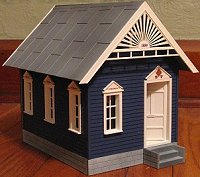 article on how to paint and assemble these so that they'll last for many years outdoors. I started with the yellow one because I liked the trim the best. (Yes, it's blue now.) I've had this outside for four years, year-round, and it still looks as good as when I set it out. article on how to paint and assemble these so that they'll last for many years outdoors. I started with the yellow one because I liked the trim the best. (Yes, it's blue now.) I've had this outside for four years, year-round, and it still looks as good as when I set it out.
In fact, starting with a "Gingerbread" series house is a pretty good idea. It's one of the simplest sets to paint and assemble, but it uses the same walls and basic construction as many of Piko's US-style buildings, including the Schoolhouse and the Church below. |
 King's Gingerbread House (gray) King's Gingerbread House (gray) Adam's Gingerbread House (blue) Adam's Gingerbread House (blue) Lewis' Gingerbread House (yellow) Lewis' Gingerbread House (yellow) Piko Little Red Schoolhouse Piko Little Red Schoolhouse | |||
Piko Old West Storefronts | ||||
| Piko Old West Storefronts - This is one of Piko's best-known line of buildings. It uses many of the same components as the "Gingerbread" series, so if you started with that one, this is the next logical step. Or vice versa.
I don't have detailed instructions on painting and assembling these from the ground up, but you'll get a lot of good tips from our articles on painting a Piko Gingerbread House or on painting plastic structures in general. The buildings in the photo to the right are examples of a few of the dozens of Western storefronts Piko has produced. In fact, I still have one of these new in a box, so when I get around to painting it up, I'll try to put a specific article together. In the meantime, the main differences between one building in the series and the next are:
Since we recommend painting anyway, and we have plenty of free downloadable graphics you can substitute, don't be too nervous if you don't like the color scheme or business name of one you come across. Piko has also made special versions of these for Christmas, to go with the (now discontinued) LGB Toy Train sets, to commemorate specific companies like Harley Davidson, and so on. The photo above is just from one collection of these. We'll list the ones we can find available online, but once you click on any of these links, chances are you see others we don't have listed yet. They all go together about the same, so don't be afraid of trying one we don't show. |
Shown above, left to right:
 Piko Hardware Store Piko Hardware Store Piko Leather Goods and Boot Store Piko Leather Goods and Boot Store Piko Acme Liquor Store Piko Acme Liquor Store Piko General Store Piko General StoreNot Shown  Piko Saloon Piko Saloon Piko Sheriff's Office Piko Sheriff's Office | |||
Piko Red River Station - This is Piko's smallest station kit, so it fits on even tiny railroads. On big railroads, it still looks good as a way station or serving small towns on your railroad. I don't have detailed instructions on painting and assembling these from the ground up, but I have embedded some painting suggestions in our Painting Plastic Structures article.
In addition, I have made my own graphics for both stations (in case you want more variety than what comes in the box). If you want to take a look, go to our Large Scale Sticker Sheets page and look at the second sheet. | 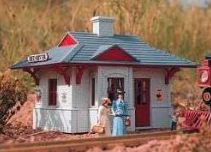  Piko Red River Station Piko Red River StationNote: As of July, 2014, no one is selling this building through Amazon; however many vendors still have them available, and it's one of Piko's most popular structures, so I'm leaving the photo up as a reference. | |||
Ground CoversMy Primer article "Groundcover 101" gives you many hints about kinds of groundcovers to use in various situations. One thing worth knowing from the start is that the sooner you get some ground covers going the better. If you have early success with a groundcover, you can save money by transplanting starts elsewhere on your railroad. Coversely, if something doesn't work for you, better you spend a few dollars finding out early than many dollars finding out later. "Groundcover 101" gives you many hints about kinds of groundcovers to use in various situations. One thing worth knowing from the start is that the sooner you get some ground covers going the better. If you have early success with a groundcover, you can save money by transplanting starts elsewhere on your railroad. Coversely, if something doesn't work for you, better you spend a few dollars finding out early than many dollars finding out later.
Springhill Nurseries, a reputable sponsor, offers several which you may find useful. Simply click on the button on the right, then use the following plant names as search terms to get started early. Note: Some groundcovers that are sold for general use are too invasive to use on garden railways. If you have a question about any particular plant, and I haven't discussed it in my "Groundcover 101" article, please contact me and I'll tell you what I know about it.
|
Dwarf and Miniature TreesMy Primer article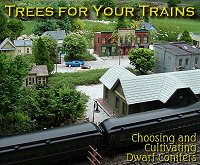 "Trees for your trains" lists a few trees that are relatively low-maintenance, and tells you how to get them started off right in your garden railroad. Here are three I have had good luck with. "Trees for your trains" lists a few trees that are relatively low-maintenance, and tells you how to get them started off right in your garden railroad. Here are three I have had good luck with.
Many more conifers are useful if you don't mind training them a bit, or at least being judicious with the trimmers. I like conifers because they can represent all kinds of trees, and they stay green all winter long, looking cheerful. A few non-confers can be useful, such as laceleaf Japanese maple. Just know that the ones you buy are all grafts - the laceleaf branches are grafted onto a "generic" Japanese maple trunk. The branches tend to grow out, not up, so you'll have to trim the lower branches for a few years to force upward growtn. Again our article on "Trees for your trains" has lots of information on trimming.
|

| Visit related pages and affiliated sites: | |||||
| - Trains and Hobbies - | |||||
 |  |
 |
 |
 |  |
 |

|

|  |
 |

|
| - Christmas Memories and Collectibles - | |||||
 |

|
 |

|
 |

|
| - Family Activities and Crafts - | |||||
 |

|

|

|

|

|
| - Music - | |||||

|
 |
 |

|

|

|

|

|

|

|

|

|

|

|

|

|

|

|